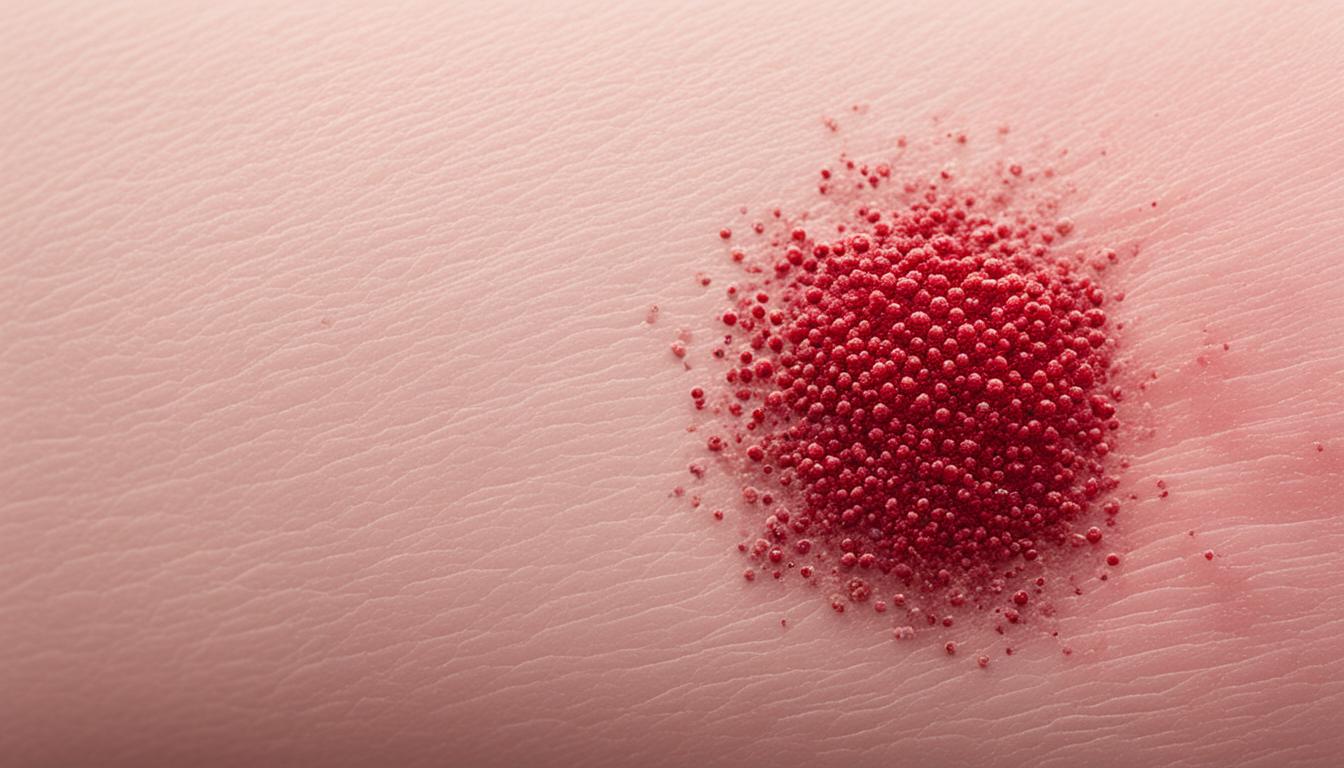Jock itch, or Tinea cruris, is a common fungal infection that troubles the groin. It makes the area red and itchy. Tight clothes, sweat, and poor hygiene create a perfect spot for the fungi to thrive. Thus, Tinea cruris appears.
The symptoms are hard to miss. You might feel an urge to scratch a lot. Your skin there may turn red and start to peel. This infection could spread to your inner thighs and buttocks.
Doctors can usually tell Tinea cruris just by looking. They might also take a part of your skin to check it under a microscope. This is to make sure it is indeed caused by a fungus.
For treatment, you’ll likely get antifungal creams, powders, or pills. These help kill the fungus and make you feel better. Sometimes, doctors use stem cell therapy to heal the skin. But, we still need more research to know its full effect.
Key Takeaways:
- Jock itch, or Tinea cruris, is a common fungal problem in the groin area.
- Causes include too much sweat, bad cleanliness, and tight clothes.
- Its signs are itchiness, redness, and flaking in the groin.
- Doctors find it by checking your skin closely and under a microscope.
- Treatments range from creams, powders, and pills to possible stem cell therapy.
Causes and Risk Factors of Tinea Cruris
Tinea cruris, or jock itch, is a fungal infection in the groin area. Knowing its causes and risks helps avoid it.
Causes:
Tinea cruris is caused by too much dermatophyte fungi in warm, moist places. The groin is perfect for these fungi, causing jock itch to grow.
Risk Factors:
- Fungal Infection: If you’ve had athlete’s foot or other fungal infections, you might get jock itch. Fungi spread from places like your feet to your groin.
- Excessive Sweating: Sweat from hard workouts or hot work conditions can lead to jock itch. The wetness from sweat helps fungi grow.
- Poor Hygiene: Not washing or drying well can help jock itch develop. Good hygiene is key to stop it.
- Tight-Fitting Clothing: Tight clothes that keep moisture in can lead to jock itch. Wear loose clothes for better air flow.
Using public showers or locker rooms can also spread jock itch. Fungi can move from one person to another in these areas.
Some people are more likely to get jock itch because their immune systems are weak. Conditions like HIV/AIDS or diabetes make it easier for fungi to start an infection.
| Risk Factors | Preventive Measures |
|---|---|
| Excessive Sweating | Wear breathable clothing and use antiperspirants to reduce sweat production. |
| Poor Hygiene | Keep the groin area clean and dry. Use mild, fragrance-free soaps and thoroughly dry the area after showering. |
| Tight-Fitting Clothing | Opt for loose-fitting underwear and clothing made from breathable materials like cotton. |
| Using Communal Facilities | Avoid walking barefoot in public showers or locker rooms. Wear sandals or flip-flops to minimize direct contact with the floor. |
Understanding Tinea cruris helps avoid it. Good hygiene, the right clothes, and keeping your groin clean and dry is key to lowering jock itch risk.
Symptoms and Diagnosis of Tinea Cruris
The main sign of Tinea cruris is a red, itchy rash in the groin. This rash, often red and itchy, brings a lot of discomfort. Sometimes, the skin might also flake or scale. Plus, it can show up on the inner thighs or buttocks.
A doctor checks for Tinea cruris by looking at the rash. They’ll see if it looks like the red, itchy rash Tinea cruris typically causes. This step is crucial for confirming the condition and ruling out others.
Sometimes, a closer look is needed to be certain. This involves examining skin scrapings under a microscope. By doing this, doctors can confirm the specific kind of fungus causing the infection. It’s a key part of making a precise diagnosis.
Stem Cell Therapy for Tinea Cruris
Stem cell therapy is new and promising for those with Tinea cruris, commonly known as jock itch. It uses regenerative medicine to help heal the skin affected by this fungus. This approach shows a lot of potential in healing the damaged skin.
Stem cells can change into different types of cells, like skin cells. This ability is key in fixing the damaged tissue from Tinea cruris.
The treatment works by applying stem cells right onto the affected skin. This can happen with injections or by placing them on the skin. This way, the stem cells help the skin heal and grow back, easing the symptoms of Tinea cruris.
Even though stem cell therapy looks very promising, more research is needed to be sure about its benefits for Tinea cruris patients in the long run. With more studies, this new treatment could be a major step forward in fighting Tinea cruris. It offers hope for better, faster ways to treat people with this condition.

